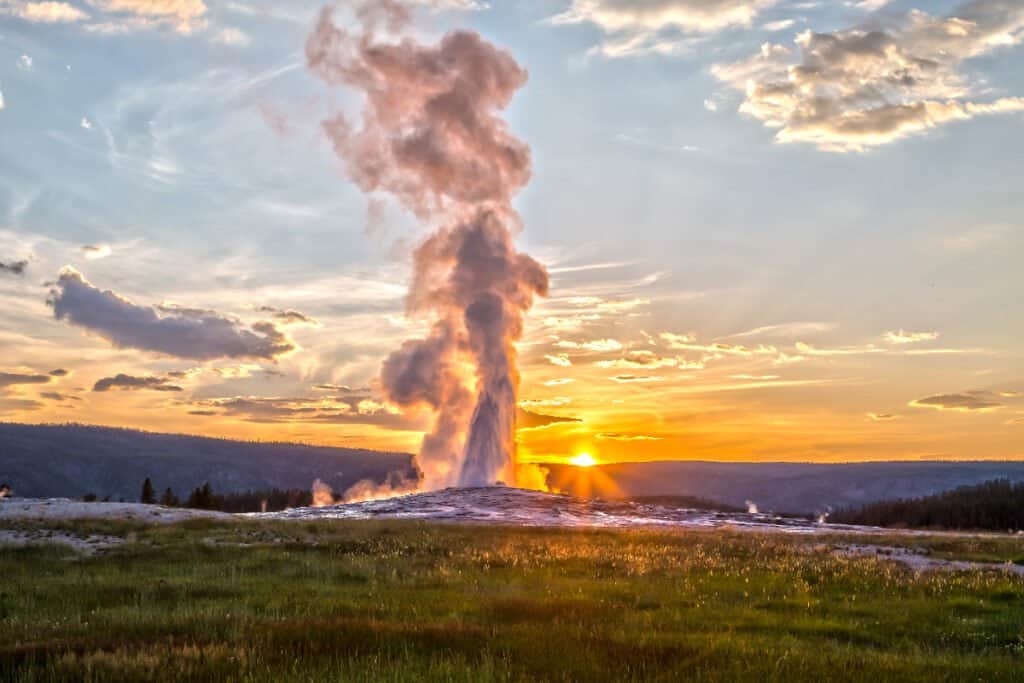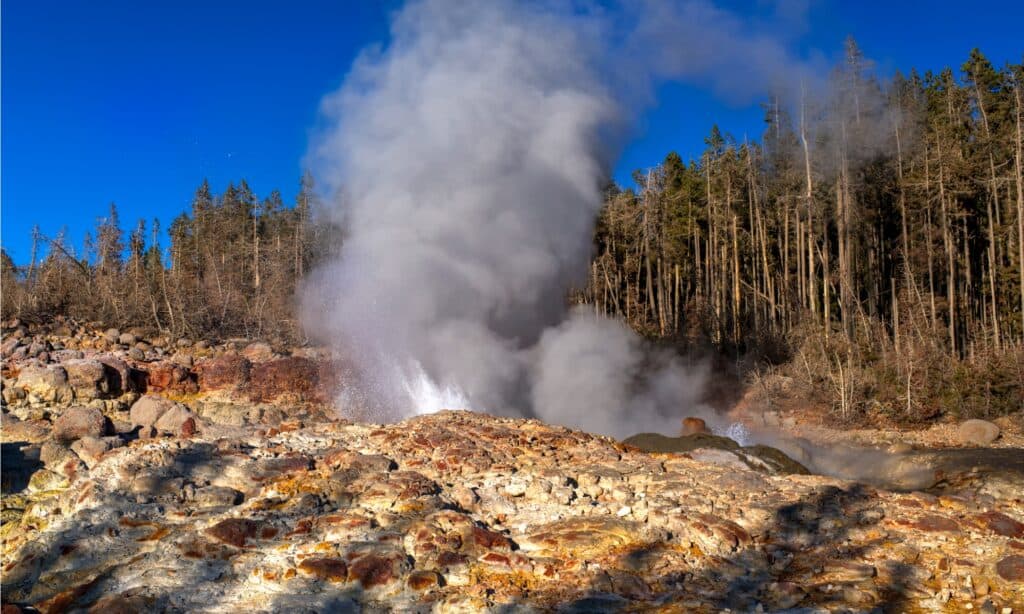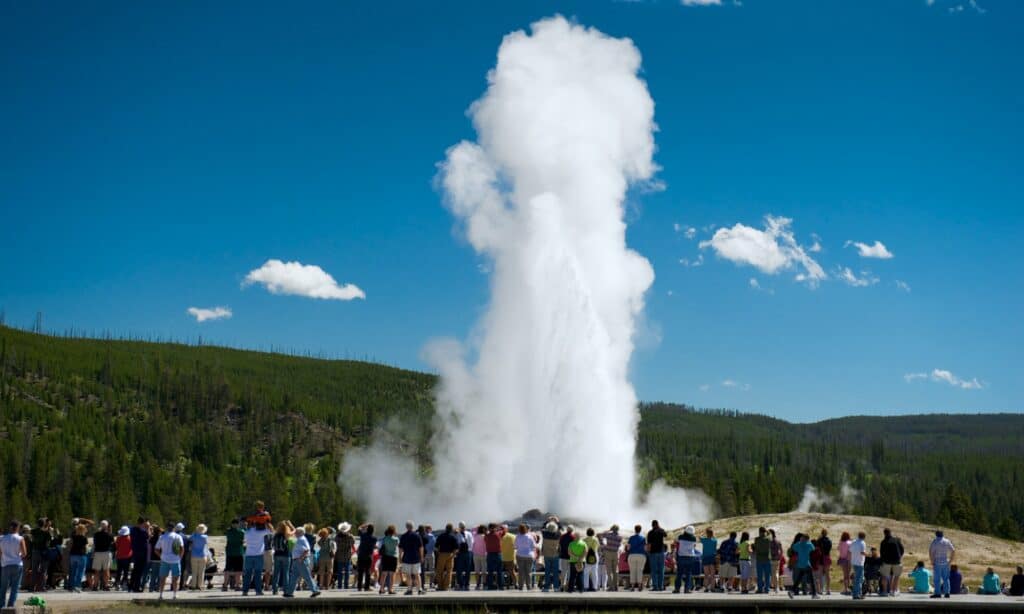You might have seen a geyser in various scientific videos or perhaps you have seen one in animated movies as a way for the characters to encounter a hurdle on their journey.
Nonetheless, you are here. And you are probably wondering what is a geyser and why is it erupting out of the ground. Or more importantly, how is all that happening?
Apart from all of these burning questions, we will also ponder upon some interesting facts. Are there geysers on other planets? How often do the geysers erupt? Is it the same amount as shown in movies, after every few seconds? Or is that just a myth? In addition, you might even find the answer to the world’s largest geyser on Earth in this blog.
What Is a Geyser?
Geysers are a rare kind of phenomenon that is observed near volcanically active areas. They are not volcanoes. If you are confused between the two, a geyser is small in size that erupts water and steam. While volcanoes are larger in size and erupt rock and ash.
As you now know, a geyser is an eruption of water and steam that may launch as high as a hundred feet. They can blast up to a thousand gallons of water during one eruption. It is like a hot spring vent on the surface of Earth that may keep erupting after a certain time period. However, as time goes by, a geyser may eventually die.
The geysers are not often solitary. You will find a whole field of geysers where one erupts and causes the others to follow. But the pattern of eruptions or duration is unpredictable.
A geyser pattern is quite hard to predict because of the uncertainty in the flow of water and heat underground. Many researchers and scientists have tried following up on the geyser patterns and their duration but the timing has always been varied.

Old Faithful in Yellowstone Park, Wyoming, USA, vents steam and hot water up to 300 feet into the air.
©Susanne Pommer/Shutterstock.com
How Does a Geyser Erupt and How Often?
When water is heated, it becomes steam. Now magnify that by a hundred times. A geyser occurs when water is super-heated and erupts through the vent on Earth’s surface in the form of a huge blast. This happens when the water becomes too hot to stay underneath the ground. Now, this is a vague explanation. Let’s further dive into it.
A geyser is formed in a vent-like surface or a hole that runs deep into the Earth’s crust. Since a geyser is mainly formed around volcanically active areas, a major source of heat comes from the hot rocks around this vent. The water below starts heating up and the pressure drops low. This combination of water and heat turns into steam. The thermal energy converts into kinetic energy due to the decrease in pressure. Eventually, the steam gushes out of the vent with a powerful force and erupts hundreds of feet into the air. The larger the cavities, the higher the eruptions.
Requirements for Geyser Eruption
- There must be a volcanically active area that has hot rocks underneath the ground.
- Underground, there must be an accumulation of water, steam, and pressure.
- Places where there is a lot of snowfall, rain, or a source of adequate water.
- Crevices or holes on the surface that releases the geyser.
The frequency of a geyser depends upon the cavity. If it is a small geyser, the eruption may take a few minutes. In contrast, a large geyser may take a few days to erupt out of the vent. However, on average, a geyser takes an hour or an hour and a half to erupt. It is never safe to assume a geyser prediction since it dies over time, once the water is flushed out completely or the temperature drops below the rising threshold.

Steamboat geyser, Yellowstone Park, Wyoming, USA
©iStock.com/SergeYatunin
Where Are Some of the Famous Geysers on Earth Found?
Geysers are rare around Earth. They are only found in five countries among the total of 195 countries on the globe. These countries are Chile, Iceland, New Zealand, Russia, and the United States. More than 700 geysers are found in the United States.
Yellowstone National Park
This is the largest geyser field in the world found in America. It has approximately 500 geysers spread out on a field. This might be the one giving inspiration to all the films showcasing dangerous geysers. It is home to more than half of the total geysers on Earth. In the USA, you can spot these geysers while traveling in Wyoming, Idaho, and Montana.

Tourists flock to watch boiling water and steam erupt from Old Faithful, the world’s largest geyser.
©iStock.com/BigshotD3
The Valley of Geysers
This is yet another famous geyser field that is found in Russia. This field has an interesting story, from its origin to the way it is today. It emerged due to volcanic activity and remains the second largest geyser field in the world. With around 200 geysers spread around the field, some of the geysers erupt at angles while others gush out in straight directions.
El Tatio
Finally, we have El Tatio in Chile. It did not have the position of the third most populous geyser region until recently when a few geysers in New Zealand died. But the interesting thing about the approximately 80 geysers found here is that they are small geysers. You will not find them gushing out steam more than 20 feet in the air.
Taupo Volcanic Zone
Located in New Zealand, this was once home to the largest geyser in the world that only caused powerful eruptions for four years. Then, it died due to a change in temperature. A lot of geysers got destroyed after this natural change. The zone currently hosts a little over 12 geysers.
A few geysers are also found in Iceland. They are 20 to 30 in number and cause small eruptions within minutes throughout the whole day.
The Largest Geyser on Earth
Steamboat Geyser in Yellowstone National Park, USA, is the biggest and the tallest active geyser in the world. The eruption can rise as high as 300 feet into the air. A peculiar fact about this geyser is that it went dormant for 50 years. Then, it rose again and remains the largest geyser to date.
This geyser has two vents that are separated by 20 feet. First, water erupts from the vent within a duration of three minutes to forty minutes. Then, a jet of steam gushes out that can last anywhere from 48 hours to a few days! During this time, water may erupt too.
Is Earth the Only Place Where a Geyser Erupts?
Yes and no. The thing about outer space is that it is relatively colder than Earth. So, steam geysers are not found on other planets. But there was one beautiful and amazing alternative discovered in the past years. Some moons of planets like Neptune and Jupiter have been found to have cold geysers.
They are also called cryovolcanoes. The process is more or less the same and the eruption comes out as volcanic snow. Scientists have made an assumption that the water source is the ocean that lies beneath the surface of these moons. But the proof is yet to embrace the scientific community.
Up Next…
Take a look at a few of our other articles about the wonders of our planet.
- Geyser vs Volcano – Find out what the difference is.
- Most Destructive Volcano Eruptions – You may have hear about some of these, but check out the full list.
- World’s Largest Mudslides – Read about these and how much damage they caused.
The photo featured at the top of this post is © Wirestock Creators/Shutterstock.com
Sources
- Wikipedia, Available here: https://en.wikipedia.org/wiki/Geyser
- National Geographic, Available here: https://education.nationalgeographic.org/resource/geyser
- Geology, Available here: https://geology.com/articles/geyser.shtml
- USGS, Available here: https://www.usgs.gov/news/featured-story/complex-dynamics-geyser-eruptions#:~:text=Geyser%20eruptions%20are%20driven%20by,the%20ground%20as%20a%20geyser.
- Knowable Magazine, Available here: https://knowablemagazine.org/article/physical-world/2018/thar-she-blows-what-why-and-where-geysers
- Yellowstone Park, Available here: https://www.yellowstonepark.com/things-to-do/geysers-hot-springs/geysers-erupt/
- Vedantu, Available here: https://www.vedantu.com/geography/geyser
- Geography Realm, Available here: https://www.geographyrealm.com/worlds-largest-active-geyser/
Thank you for reading! Have some feedback for us? Contact the AZ Animals editorial team.







